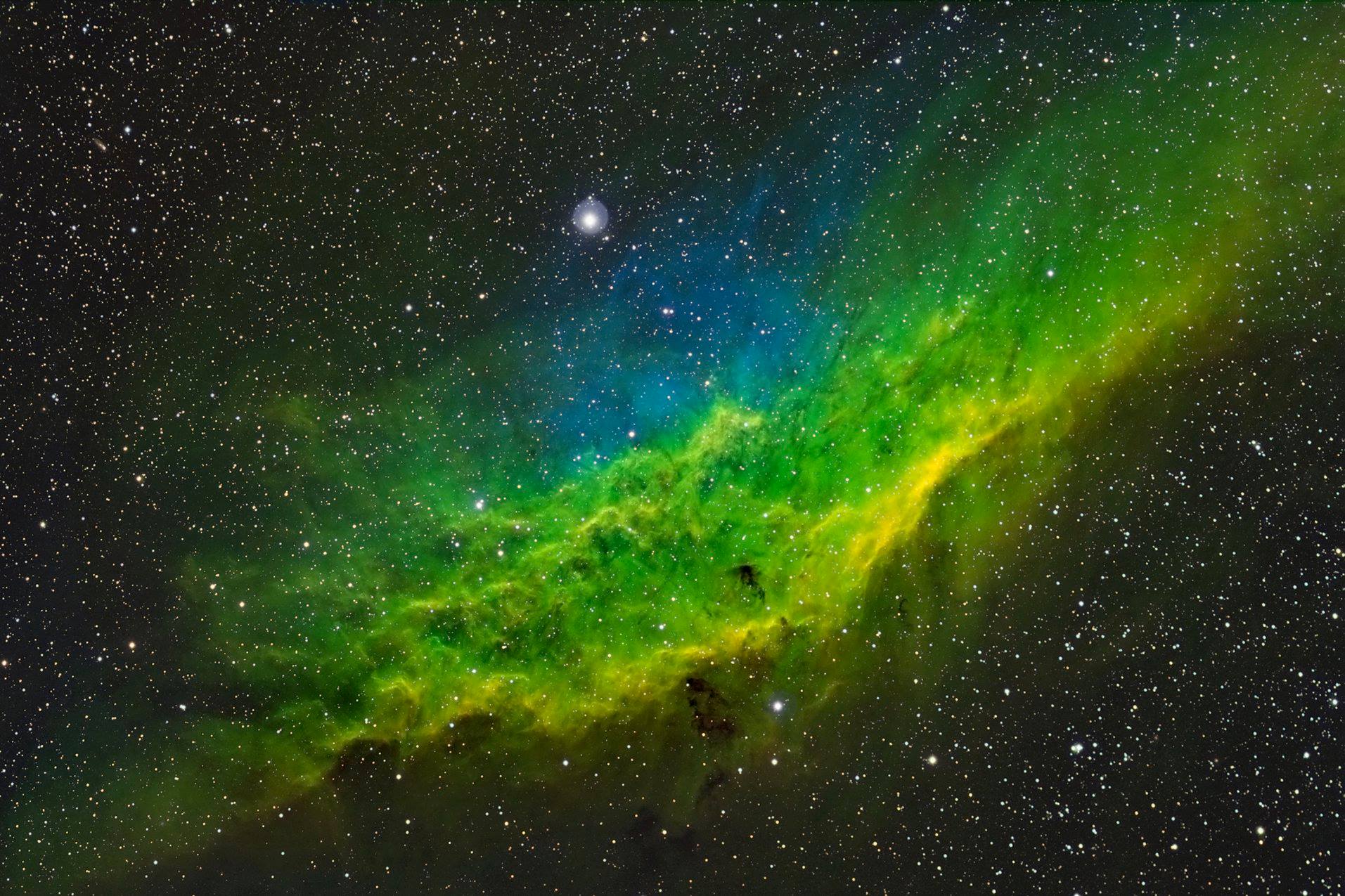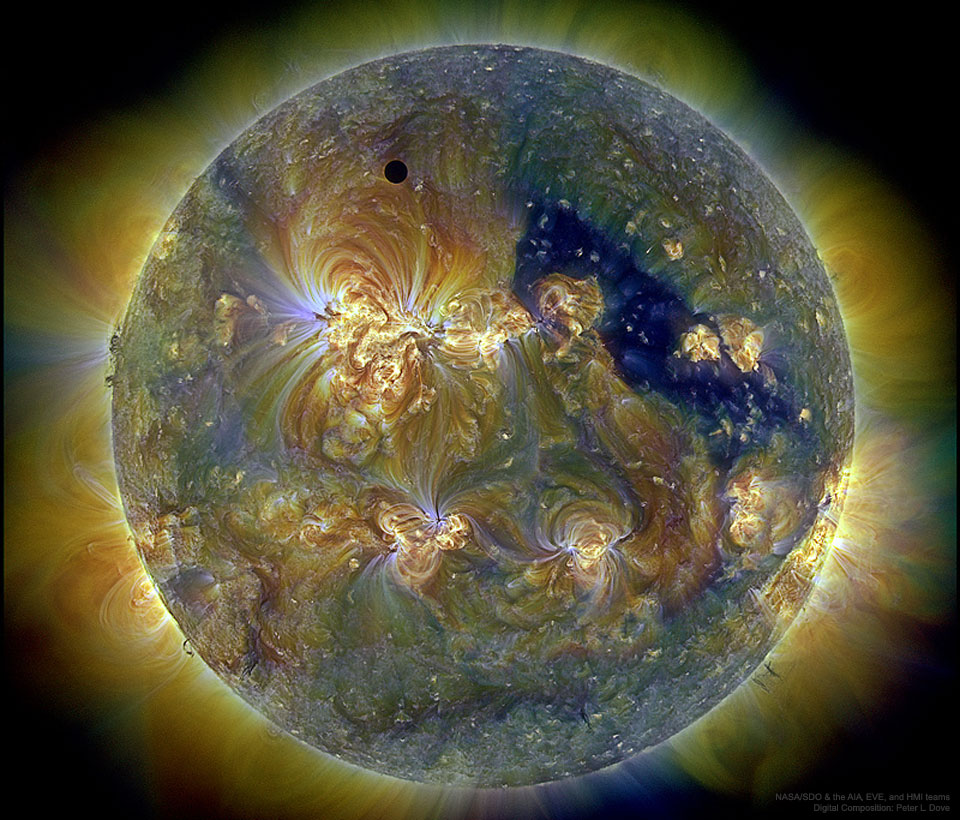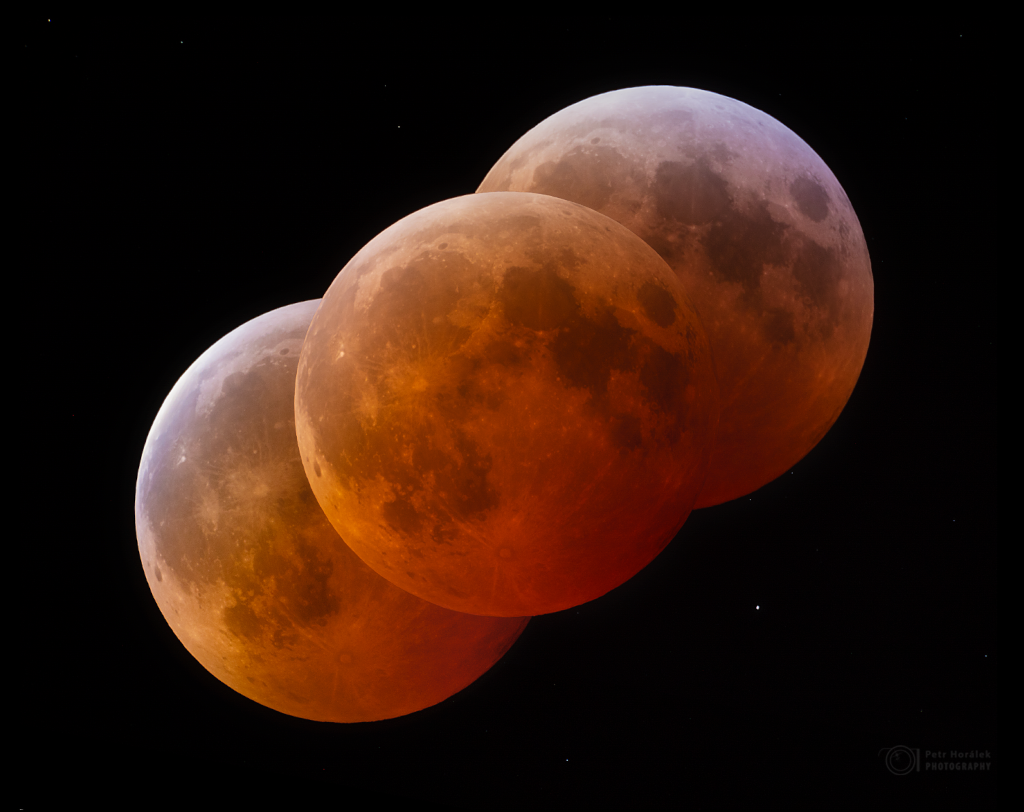Blog
The Cosmos with NGC 1499
The California Nebula (NGC 1499) is an emission nebula located in the constellation Perseus. It is so named because it appears to resemble the outline of the US State of California on long exposure photographs. It is almost 2.5° long on the sky and, because of its very low surface brightness, it is extremely difficult to observe visually. It can be observed with a Hβ filter (isolates the Hβ line at 486 nm) in a rich-field telescope under dark skies. It lies at a distance of about 1,000 light years from Earth. Its fluorescence is due to excitation of the Hβ line in the nebula by the nearby prodigiously energetic O7 star, xi Persei (also known as Menkib, seen at center below it in the inset at right).
The California Nebula was discovered by E. E. Barnard in 1884.
A coincidence is that the California Nebula transits in the zenith in central California as the latitude matches the declination of the object.

Paul Lorin Kantner (March 17, 1941 – January 28, 2016) was an American rock musician. He is best known as the co-founder, rhythm guitarist, and a secondary vocalist of Jefferson Airplane, a leading psychedelic rock band of the counterculture era. He continued these roles as a member of Jefferson Starship, Jefferson Airplane’s successor band.
Jefferson Airplane was formed in 1965 when Kantner met Marty Balin. Kantner eventually became the leader of the group and led it through its highly successful late-1960s period. In 1970, while still active with Jefferson Airplane, Kantner and several Bay Area musicians recorded the album Blows Against the Empire, which was co-credited to both Paul Kantner and “Jefferson Starship”.
Jefferson Airplane continued to record and perform until 1973. Kantner revived the Jefferson Starship name in 1974 and continued to record and perform with them through 1984. He later led a reformed Jefferson Starship from 1992 until his death in 2016. Kantner had the longest continuous membership with the band, with 19 years in the original run of Jefferson Airplane and Jefferson Starship and 24 years in the revived Jefferson Starship. At times, he was the only founding Jefferson Airplane member to remain in Jefferson Starship. He was inducted into the Rock and Roll Hall of Fame as a member of Jefferson Airplane in 1996.
more...Lovie Lee (March 17, 1909 – May 23, 1997) was an American electric blues pianist and singer. He is best known for his work accompanying Muddy Waters. He also recorded a solo album, in 1992. He was the “adoptive stepfather” of the bluesman Carey Bell and thus the “grandfather” of Lurrie Bell.
more...Alfred Newman (March 17, 1900 – February 17, 1970) was an American composer, arranger, and conductor of film music. From his start as a music prodigy, he came to be regarded as a respected figure in the history of film music. He won nine Academy Awards and was nominated 45 times, contributing to the extended Newman familybeing the most Academy Award-nominated family, with a collective 92 nominations in various music categories.
In a career spanning more than four decades, Newman composed the scores for over 200 motion pictures. Some of his most famous scores include Wuthering Heights, The Hunchback of Notre Dame, The Mark of Zorro, How Green Was My Valley, The Song of Bernadette, Captain from Castile, All About Eve, Love is a Many Splendored Thing, Anastasia, The Diary of Anne Frank, How The West Was Won, The Greatest Story Ever Told, and his final score, Airport, all of which were nominated for or won Academy Awards. He is perhaps best known for composing the fanfare which accompanies the studio logo at the beginning of 20th Century Fox‘s productions. Prior to commencing his employment with 20th Century Fox, Newman composed the fanfares which are most often associated with Samuel Goldwyn productions and David O. Selznick productions.
Newman was also highly regarded as a conductor, and arranged and conducted many scores by other composers, including George Gershwin, Charlie Chaplin, and Irving Berlin. He also conducted the music for many film adaptations of Broadway musicals (having worked on Broadway for ten years before coming to Hollywood), as well as many original Hollywood musicals.
He was among the first musicians to compose and conduct original music during Hollywood’s Golden Age of movies, later becoming a respected and powerful music director in the history of Hollywood. Newman and two of his fellow composers, Max Steiner and Dimitri Tiomkin, were considered the “three godfathers of film music”.
more...Paul Horn (March 17, 1930 – June 29, 2014 Vancouver) was an American flautist, saxophonist, composer and producer. He became a pioneer of world and new age music with his 1969 album Inside. He received five Grammy nominations between 1965 and 1999, including three nominations in 1965.
more...Nathaniel Adams Coles (March 17, 1919 – February 15, 1965), known professionally as Nat King Cole, alternatively billed as Nat “King” Cole, was an American singer, jazz pianist, and actor. Cole’s career as a jazz and pop vocalist started in the late 1930s and spanned almost three decades where he found success and recorded over 100 songs that became hits on the pop charts.
Cole started his career as a jazz pianist in the late 1930s, when he formed the King Cole Trio, which became the top-selling group (and the only black act) on Capitol Records in the 1940s. Cole’s trio was the model for small jazz ensembles that followed. Starting in 1950, he transitioned to become a solo singer billed as Nat King Cole. Despite achieving mainstream success, Cole faced intense racial discrimination during his career. While not a major vocal public figure in the civil rights movement, Cole was a member of his local NAACP branch and participated in the 1963 March on Washington. He regularly performed for civil rights organizations. From 1956 to 1957, Cole hosted the NBC variety series The Nat King Cole Show, which became the first nationally broadcast television show hosted by a black American.
Some of Cole’s most notable singles include “Unforgettable“, “Smile“, “L-O-V-E“, “Nature Boy“, “When I Fall in Love“, “Let There Be Love“, “Mona Lisa“, “Autumn Leaves“, “Stardust“, “Straighten Up and Fly Right“, “The Very Thought of You“, “For Sentimental Reasons“, “Embraceable You” and “Almost Like Being in Love“. His 1960 Christmas album The Magic of Christmas (also known as The Christmas Song), is the best-selling Christmas album released in the 1960s; and was ranked as one of the 40 essential Christmas albums (2019) by Rolling Stone. In 2022, Cole’s recording of “The Christmas Song“, broke the record for the longest journey to the top ten on the BillboardHot 100, when it peaked at number nine, 62 years after it debuted on the chart; and was selected by the Library of Congress for preservation in the United States National Recording Registry. NPR named him one of the 50 Great Voices. Cole received numerous accolades including a star on the Hollywood Walk of Fame (1960) and a Special Achievement Golden Globe Award. Posthumously, Cole has received the Grammy Lifetime Achievement Award (1990), along with the Sammy Cahn Lifetime Achievement Award (1992) and has been inducted into the DownBeat Jazz Hall of Fame (1997), Rock and Roll Hall of Fame (2000), and the National Rhythm & Blues Hall of Fame (2020).
Cole was the father of singer Natalie Cole (1950–2015), who covered her father’s songs in the 1991 album Unforgettable… with Love.
more...Abraham John Bond Jr., known as Son Bonds (March 16, 1909 – August 31, 1947), was an American country blues guitarist, singer and songwriter. He was a working associate of Sleepy John Estes and Hammie Nixon. He was similar to Estes in his guitar-playing style. According to the music journalist Jim O’Neal, “the music to one of Bonds’s songs, ‘Back and Side Blues’ (1934), became a standard blues melody when Sonny Boy Williamson I, from nearby Jackson, Tennessee, used it in his classic “Good Morning, School Girl“. The best-known of Bonds’s other works are “A Hard Pill to Swallow” and “Come Back Home.”
more...This was a very unusual type of solar eclipse. Typically, it is the Earth’s Moon that eclipses the Sun. In 2012, though, the planet Venus took a turn. Like a solar eclipse by the Moon, the phase of Venus became a continually thinner crescent as Venus became increasingly better aligned with the Sun. Eventually the alignment became perfect and the phase of Venus dropped to zero. The dark spot of Venus crossed our parent star. The situation could technically be labeled a Venusian annular eclipse with an extraordinarily large ring of fire. Pictured here during the occultation, the Sun was imaged in three colors of ultraviolet light by the Earth-orbiting Solar Dynamics Observatory, with the dark region toward the right corresponding to a coronal hole. Hours later, as Venus continued in its orbit, a slight crescent phase appeared again. The next Venusian transit across the Sun will occur in 2117.

more...
Minoru Miki (Japanese: 三木 稔, 16 March 1930 – 8 December 2011) was a Japanese composer and Artistic director. He was known for promoting Japanese, Chinese and Korean traditional instruments as well as some of their performers.
In his catalogue these traditional instruments figure solo or in various types of ensembles, with and without Western instruments. His catalogue demonstrates a large stylistic and formal diversity including operas and other kinds of stage music; orchestral, concerto, chamber and solo music, as well as music for films. His work has found international recognition placing Miki in the company of other celebrated Japanese composers such as Tōru Takemitsu.
Minoru was a pioneer in the composition of contemporary classical music for large ensembles of traditional Japanese musical instruments. In 1964, he founded the Nihon Ongaku Shūdan (Pro Musica Nipponia ensemble), also known as Ensemble Nipponia, for which he has composed extensively.
more...Ramzan Paskayev (Chechen: Рамзан Паскаев) (born March 16, 1947, in Taraz, Kazakhstan) is a Chechen accordionist and folk musician. He is regarded by many as the contemporary successor to late Chechen accordionist Umar Dimayev.
more...
Fred Neil (March 16, 1936 – July 7, 2001 Cleveland) was an American folk singer-songwriter active in the 1960s and early 1970s. He is mainly known through other people’s recordings of his material – particularly “Everybody’s Talkin’“, which became a hit for Harry Nilsson after it was used in the film Midnight Cowboy in 1969. Though highly regarded by contemporary folk singers, he was reluctant to tour and spent much of the last 30 years of his life assisting with the preservation of dolphins.
more...Thomas Lee Flanagan (March 16, 1930 – November 16, 2001) was an American jazzpianist and composer. He grew up in Detroit, initially influenced by such pianists as Art Tatum, Teddy Wilson, and Nat King Cole, and then by bebop musicians. Within months of moving to New York in 1956, he had recorded with Miles Davis and on Sonny Rollins‘ album Saxophone Colossus. Recordings under various leaders, including Giant Stepsof John Coltrane, continued well into 1962, when he became vocalist Ella Fitzgerald‘s full-time accompanist. He worked with Fitzgerald for three years until 1965, and then in 1968 returned to be her pianist and musical director, this time for a decade.
After leaving Fitzgerald in 1978, Flanagan attracted praise for the elegance of his playing, which was principally in trio settings when under his own leadership. In his 45-year recording career, he recorded more than three dozen albums under his own name and more than 200 as a sideman. By the time of his death, he was one of the most widely admired jazz pianists and had influenced both his contemporaries and later generations of players.
more...Ralph Anthony MacDonald (March 15, 1944 – December 18, 2011) was an American percussionist, steelpan virtuoso, songwriter, musical arranger, and record producer.
His compositions include “Where Is the Love“, a Grammy Award winner for the duet of Roberta Flack and Donny Hathaway; “Just the Two of Us“, recorded by Bill Withers and Grover Washington Jr.; and “Mister Magic” recorded by Grover Washington Jr.
more...On March 14 the Moon was Full. In an appropriate celebration of Pi day, that put the Moon 3.14 radians (180 degrees) in ecliptic longitude from the Sun in planet Earth’s sky. As a bonus for fans of Pi and the night sky, on that date the Moon also passed directly through Earth’s umbral shadow in a total lunar eclipse. In clear skies, the colors of an eclipsed Moon can be vivid. Reflecting the deeply reddened sunlight scattered into Earth’s shadow, the darkened lunar disk was recorded in this time series composite image from Cerro Tololo Observatory, Chile. The lunar triptych captures the start, middle, and end of the total eclipse phase that lasted about an hour. A faint bluish tint seen just along the brighter lunar limb at the shadow’s edge is due to sunlight filtered through Earth’s stratospheric ozone layer.

more...
Philip Chapman Lesh (March 15, 1940 – October 25, 2024 Berkeley, CA) was an American musician and a founding member of the Grateful Dead, with whom he developed a unique style of playing improvised six-string bass guitar. He was their bassist throughout their 30-year career.
After the group disbanded in 1995, Lesh continued the tradition of Grateful Dead family music with a side project, Phil Lesh and Friends, which paid homage to the Dead’s music by playing their repertoire, as well as songs by members of his own group. Lesh operated a music venue called Terrapin Crossroads. From 2009 to 2014, he performed in Furthur alongside former Grateful Dead bandmate Bob Weir. He scaled back touring in 2014 but continued to perform concerts.
more...Sylvester Stewart (born March 15, 1943), better known by his stage name Sly Stone, is an American musician, songwriter, and record producer who is most famous for his role as frontman for Sly and the Family Stone, playing a critical role in the development of funk with his pioneering fusion of soul, rock, psychedelia and gospel in the 1960s and 1970s. AllMusic stated that “James Brown may have invented funk, but Sly Stone perfected it,” and credited him with “creating a series of euphoric yet politically charged records that proved a massive influence on artists of all musical and cultural backgrounds.” Crawdaddy! has credited him as the founder of the “progressive soul” movement.
Born in Texas and raised in the Bay Area city Vallejo in Northern California, Stone mastered several instruments at an early age and performed gospel music as a child with his siblings (and future bandmates) Freddie and Rose. In the mid-1960s, he worked as both a record producer for Autumn Records and a disc jockey for San Francisco radio station KDIA. In 1966, Stone and his brother Freddie joined their bands together to form Sly and the Family Stone, a racially integrated, mixed-gender act. The group would score hits including “Dance to the Music” (1968), “Everyday People” (1968), “Thank You (Falettinme Be Mice Elf Agin)” (1969), “I Want to Take You Higher” (1969) “Family Affair” (1971) and “If You Want Me to Stay” (1973) and acclaimed albums including Stand! (1969), There’s a Riot Goin’ On (1971) and Fresh(1973).
By the mid-1970s, Stone’s drug use and erratic behavior effectively ended the group, leaving him to record several unsuccessful solo albums. He toured or collaborated with artists such as Parliament-Funkadelic, Bobby Womack, and Jesse Johnson. In 1993, he was inducted into the Rock and Roll Hall of Fame as a member of the group. He took part in a Sly and the Family Stone tribute at the 2006 Grammy Awards, his first live performance since 1987. He released the autobiography Thank You (Falettinme Be Mice Elf Agin) in 2023.
more...More Posts
- Billy Higgins
- Curtis Amy
- Art Blakey
- World Music with Trio Dhoore
- Daily Roots with the Pioneers
- Surviving the Pandemic and Realizing Racial Justice
- The Cosmos with the Virgo Cluster
- Cyril Neville
- John Prine
- Junior Mance
- Thelonious Monk
- Harry “Sweets” Edison
- World Fusion with Gitkin
- Daily Roots with the Gaylads
- Surviving the Pandemic and Realizing Racial Justice
- The Cosmos with NGC 1365
- Chucho Valdes
- John Lennon
- Abdullah Ibrahim
- Yusef Lateef